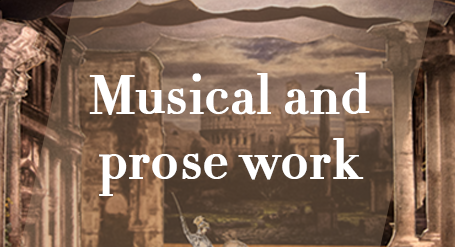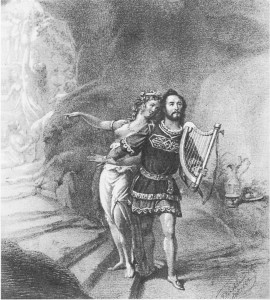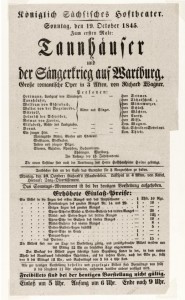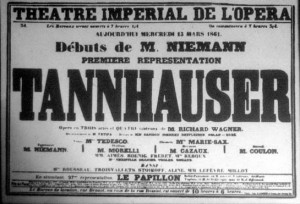
The musical work of Richard Wagner is composed of operas or “musical dramas” ranging from “Fairies” (Die Feen) to “Parsifal”. A detailed presentation of each of these major works is associated here with a set of thematic articles, placing them not only in the context of his personal life but also in his social, economic and cultural context. This section also includes all the musical works (excluding opera) and his literary work.
Tannhäuser and the Minstrel’s Contest at the Wartburg, WWV70
Tannhäuser und der Sängerkrieg auf Wartburg, WWV70
In short
 Tannhäuser and the Minstrel’s Contest at the Wartburg (WWV70) is the fifth of Richard Wagner’s operas, namely the second of the composer’s operas created during his “mature” phase. Composed between 1842 and 1845, after the mixed success received by The Flying Dutchman (Der Fliegende Holländer, WWV 63), Tannhäuser was conceived to be presented at the Opera of the Royal Court of Saxony where Wagner then performed the duties of choirmaster.
Tannhäuser and the Minstrel’s Contest at the Wartburg (WWV70) is the fifth of Richard Wagner’s operas, namely the second of the composer’s operas created during his “mature” phase. Composed between 1842 and 1845, after the mixed success received by The Flying Dutchman (Der Fliegende Holländer, WWV 63), Tannhäuser was conceived to be presented at the Opera of the Royal Court of Saxony where Wagner then performed the duties of choirmaster.
The idea was born when he was in Paris, while he unsuccessfully tried to convince the direction of the Paris Opera to agree to stage Rienzi, and then The Flying Dutchman.
Indeed, he had been offered by his philologist friend Samuel Lehrs, also in exile in Paris, a number of collections gathering various popular legends inherited from ancient times, this brilliant intellectual who graduated from the University of Königsberg knowing the composer’s tastes in terms of history and legends.
Moved while reading these texts whose timeless quality he discovered as time went by, Wagner imagined almost instantly the frameworks of dramas or operas to come, all inherited from the legends of medieval Germany: among them, Tannhäuser obviously, but also Lohengrin or The Master-Singers of Nuremberg (Die Meistersinger von Nürnberg). Among the collections offered by Lehrs to Wagner was a work entitled Tannhäuser, and another entitled The Minstrel’s Contest at the Wartburg (Der Sängerkrieg auf der Wartburg).
 More concerned with the dramatic scope of his librettos than with historical accuracy, Wagner introduced in his drama the character of Elisabeth of Thuringia, whose life did not coincide with the Minnesänger tournaments, as well as certain emblematic figures that really existed (the courteous singers that were Wolfram von Eschenbach and Heinrich von Ofterdingen).
More concerned with the dramatic scope of his librettos than with historical accuracy, Wagner introduced in his drama the character of Elisabeth of Thuringia, whose life did not coincide with the Minnesänger tournaments, as well as certain emblematic figures that really existed (the courteous singers that were Wolfram von Eschenbach and Heinrich von Ofterdingen).
From these improbable fusions of legends came about a coherent libretto that highlighted several key themes such as the opposition between carnal love and courtly love, redemption through love as well as the insubordination of the hero (to whom the composer gladly identified himself) to the rigidity of a too codified way of life.
Musically, Tannhäuser shows the progress made in the reform that the composer had initiated with The Flying Dutchman (Der Fliegende Holländer), even if the work still owes a lot to the “Grand Opéra à la française”: recurring presence of leitmotifs, introduction of a quasi-continuous melody with the progressive disappearance of the cutting in numbers characteristic of the classical opera, quasi-symphonic orchestration…
Tannhäuser, in its first version (commonly known today as the “Dresden version“) was created on 19 October, 1845 at the Royal Opera House of the Court of Saxony (Königlich Sächsisches Hoftheater) in Dresden. The cast included the faithful Wilhelmina Schröder-Devrient (Venus), as well as the composer’s own niece, Johanna (for the record, Johanna having been ill, the premiere had to be postponed for a few days). At the time of its production, the work took the critics aback, who took a long time to finally give him good press. On the other hand, the public seemed to be much more forgiving. With Tannhäuser, he found, indeed, certain “canons” of the great romantic opera. As the performances passed, Tannhäuser triumphed everywhere in Germany.
Wagner, undoubtedly aware of a few weaknesses, in particular concerning the dramatic evolution of the libretto, was forced to rework his score several times, notably in 1860.
 Indeed, on this date, the composer despaired to have his Tristan and Isolde performed, and lived in the most precarious poverty.
Indeed, on this date, the composer despaired to have his Tristan and Isolde performed, and lived in the most precarious poverty.
It was then that he received surprising news: thanks to the support of the Austrian Ambassador’s wife in Paris, Princess Pauline von Metternich, Emperor Napoleon III agreed to have Tannhäuser produced on the great stage of the Paris Opera. This news was a revenge for Wagner for whom the name of the capital was until now synonymous with failure. The work must be given in French, in accordance with tradition; the translation of the libretto was attributed to Charler Nuitter and the choreography of the ballet scene (the “Venusberg Bacchanale“) to Marius Petipa.
Unfortunately, for reasons that were more political than artistic, the performances were the subject of a resounding cabal, and Tannhäuser was pulled after only three performances. Wagner, for whom this production had significantly reconsidered his total body of work, thus created what is now usually called the “Paris version” of Tannhäuser. Undoubtedly one of the composer’s most famous works, Tannhäuser did not take long to establish itself on the lyrical stages around the world. His famous overture, the melody playing during Elisabeth’s entrance (Act II) as well as his Prayer (Act III), Entry of the Guests or Song to the Evening Star are among the most popular pieces of Richard Wagner’s work.
NC
If you wish to share further information about this article, please feel free to contact us !
